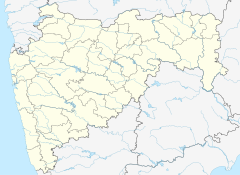Vithoba Temple, Pandharpur
| Vitthal Temple, Pandharpur | |
|---|---|

Chief (eastern) entrance of the temple, with houses the "Namdeva chi Payari". The small blue temple in front of the gate is saint Chokhamela's memorial.
|
|
|
Location in Maharashtra
|
|
| Geography | |
| Coordinates | 17°40′N 75°20′E / 17.67°N 75.33°ECoordinates: 17°40′N 75°20′E / 17.67°N 75.33°E |
| Country | India |
| State | Maharashtra |
| District | Solapur |
| Location | Pandharpur |
| Culture | |
| Sanctum | Vithoba alias Vitthala |
| Important festivals | Aashadhi Ekadashi, Kartiki Ekadashi. |
| Architecture | |
| Architectural styles | Hemadpanthi |
| History and governance | |
| Date built | unknown, before 13th century |
| Creator | The Pandharpur temple was built in the middle of the thirteenth century by King Visnuvardhana of the Hoysala dynasty. |
Vitthal temple (Marathi श्री विठ्ठल-रूक्मिणी मंदिर, Kannada ಶ್ರೀ ವಿಠ್ಠಲ ರುಕ್ಮಿಣಿ ದೇವಸ್ಥಾನ) is the main centre of worship for Vitthal, believed to be a form of Bhagawan Krishna or Vishnu and his consort Rakhumai. It is the most visited temple in Maharashtra. The Warkaris start marching from their homes to the temple of Pandharpur in groups called Dindi (procession) to reach on Aashadhi Ekadashi and Kartiki Ekadashi. A dip in the holy river Chandrabhaga on whose banks Pandharpur resides, is believed to have power to wash all sins. All the devotees are allowed to touch the feet of the idol of Vithoba. In May 2014, the temple became first in India to invite women and people from backward classes as priests.
The saga of Pundalik is one of the most important Mahima legends about Vithoba. How Vithoba came to Pandharpur is a story in which Pundalik is vital. Pundalik is a devoted son to his parents Janudev and Satyavati, who lived in a forest called Dandirvan. But after his wedding, Pundalik begins ill-treating his parents. Tired with their son’s misbehavior and ill treatment, the elderly couple decide to leave for Kashi. Legend holds that people who die in the city of Kashi attain salvation and emancipation from the cycle of birth and death; so, many pious Hindus in the bygone era would relocate to Kashi as their end drew near.
However, the elderly couple are not destined to escape their suffering so easily. Upon hearing his parents' plans, Pundalik and his wife decide to join them on pilgrimage. The ill treatment continues. While the youthful son and his wife ride on horseback, the frail old couple walk in bad weather. Pundalik even makes his old parents work to make his own journey comfortable. Every evening, when the party camps for the night, the son forces his parents to groom the horses and do other jobs.
On the way to Kashi, the group reached the ashram (hermitage) of a pious and venerable sage, Kukkutswami. Exhausted, the family decides to spend a few days there. That night, when all were asleep, Pundalik by chance is awake and sees a remarkable vision. Just before dawn, a group of beautiful young women, dressed in soiled clothes, enter the ashram; they clean the floor, fetch water and wash the venerable sage’s clothes. After finishing their chores, they go to the prayer-room. When they reappear after prayer, their clothes are spotlessly clean. Then, they vanish as inexplicably as they had appeared.
...
Wikipedia

